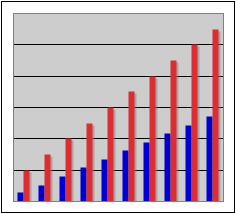
I was listening to Hawaii Public Radio’s semi-annual fund drive when a couple of things struck me. Regardless of your views on public radio and their news coverage, there are some important business lessons to be learned from how they conduct their fund drives.
The first thing you notice is that they have set some very specific goals. The second is that their entire focus during the drive is on those goals. They are unwavering in their focus. They set their targets, focus all their efforts on achieving them, and monitor their progress in extreme detail in real-time.
Their goals start with the overall dollar amount they need. You will notice that this is a fairly precise number, not some generally rounded figure. For the just completed drive, the target was $808,000. Not $800,000 or $850,000, but $808,000. You get the feeling right from the beginning that they know what they’re doing and have a well developed plan because they have set such a precise target.
Not only do they set a dollar goal, they set a completion date goal. They communicate from the beginning just how long the drive is expected to take. Again, it is precise. Not “a week or two”, but a fixed number of days. For the current drive, the target was ten days. So you have set goals of $808,000 in ten days.
To help keep the focus strong, and to break down those large goals that are hard to really get your mind around, they break the goal down into segments. The segments are aligned with the programs that are broadcast throughout the day, and each segment has its own specific dollar goal. The dollar goals vary throughout each segment, so one segment might have a goal of $1,500, while another might have a goal of $3,000.
Another thing you will notice is that during the on-air campaign, the staff and volunteers are asking for specific, or target, donation levels. They don’t just ask for a donation, they ask for a specific level of support, such as the True-Believer, or the Dollar-A-Day levels.
You can clearly see that in order to be able to so finely tune their goals they have to have large amounts of data at their fingertips. But not just large amounts, they have the right data. They are able to effectively analyze prior results so that they can define their goals and break them down into segments. The whole thing is very impressive if you think about it.
The lesson is – set specific, measurable, goals, use data, the right data, to define those goals, and monitor progress towards achieving them.
 I'm a bad boy. I've been branded a spammer. On the same day that a Russian spam sender was shut down for sending something like 50 billion spams, I tried sending my newsletter to 425 people. Because I added people to my list who I've met and collected their business cards and some of them no longer work at the same place or no longer have the same email address, I've been banned. Temporarily.
I'm a bad boy. I've been branded a spammer. On the same day that a Russian spam sender was shut down for sending something like 50 billion spams, I tried sending my newsletter to 425 people. Because I added people to my list who I've met and collected their business cards and some of them no longer work at the same place or no longer have the same email address, I've been banned. Temporarily.







